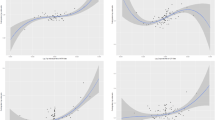Abstract
A positive association between rates of in-migration and out-migration across locations has long been observed. This apparent paradox has usually been attributed to the impact of in-migration on population composition. We argue here that the intrinsic structure of population dynamics may also induce this effect, and we develop a formal model of this process. Empirical analyses using migration data for states in the U.S. over 1955–1960, 1965–1970, and 1975–1980 show that the intrinsic mechanism may swamp the compositional effect.
Similar content being viewed by others
References
Beaman, J. and McGinnis, R. 1977. Modelling out-migration from cities to allow parameter estimation and related hypothesis testing. InMathematical models of sociology, ed. P. Krishnan, University of Keele, Monograph 24, pp. 193–229.
Bogue, D. J., Shryock, H. S., Jr., and Hoerman, S. A. 1957.Streams of migration between subregions: a pilot study of migration flows between environments, vol. 1, subregional migration in the United State, 1935–40. Oxford, OH: Scripps Foundation.
Da Vanzo, J. 1976.Why families move: a model of the geographic mobility of married couples. Santa Monica, CA: Rand Corporation.
Gleave, D. and Cordey-Hayes, M. 1977. Migration dynamics and labor turnoverProgress in Planning 8 (part 1): 1–95.
Kriesberg, E. M. and Vining, D. R. 1978. On the contribution of out-migration to changes in net migration: a time series confirmation of Beale's cross-sectional results.Annals of Regional Science 12: 1–11.
Lieberson, S. 1980. The interpretation of net migration rates. InSociological methodology, ed. K. Schuessler. Washington, DC: American Sociological Association, pp. 176–90.
Lowry, I. S. 1966.Migration and metropolitan growth: two analytical models. Los Angeles, CA: Institute of Government and Public Affairs, University of California.
Miller, A. 1967. The migration of employed persons to and from metropolitan areas of the United States.Journal of the American Statistical Association 62: 1418–32.
Miller, E. 1973. Is out-migration affected by economic conditions?Southern Economic Journal 39: 396–405.
Morrison, P. A. 1971. Chronic movers and the future redistribution of population: a longitudinal analysis.Demography 8: 171–84.
Perloff, H. S., Dunn, E. S., Jr., Lampard, E. E., and Muth, R. F. 1960.Regions, resources, and economic growth. Baltimore, MD: Johns Hopkins Press and Resources for the Future.
Plane, D., Rogerson, P., and Rosen, A. 1984. The cross-regional variation of in-migration and outmigration.Geographical Analysis 16: 162–75.
Ravenstein, E. G. 1885. The laws of migration, part 1.Journal of the Royal Statistical Society 48: 167–227.
Renshaw, V. 1975. The relationship of gross migration to net migration: a short run, long run distinction.Regional Science Perspectives 5: 109–24.
Rogers, A. 1966. The multiregional matrix growth operator and the stable interregional age structure.Demography 3: 537–44.
Stone, L. O. 1968. Stable migration rates from the multiregional growth matrix operator.Demography 5: 439–42.
Stone, L. O. 1971. On the correlation between metropolitan in-migration and out-migration by occupation.Journal of the American Statistical Association 66: 693–701.
Tabuchi, T. 1985. Time series modeling of gross migration and dynamic equilibrium.Journal of Regional Science 25: 65–83.
Vanderkamp, J. 1971. Migration flows, their determinants and the effects of return migration.Journal of Political Economy 79: 1012–31.
Author information
Authors and Affiliations
Rights and permissions
About this article
Cite this article
Mueser, P.R., White, M.J. Explaining the association between rates of in-migration and out-migration. Papers of the Regional Science Association 67, 121–134 (1989). https://doi.org/10.1007/BF01934671
Issue Date:
DOI: https://doi.org/10.1007/BF01934671




